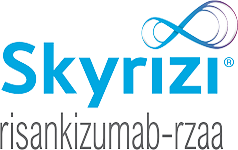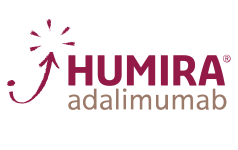For patients 2 years of age and older with moderate to severe polyarticular juvenile idiopathic arthritis (JIA)
Symptom improvement and fewer patients experiencing disease flare in JIA1
DE038
Patients 4 to 17 years of age with moderate to severe polyarticular JIA who were naïve to biologic DMARDs1,2
DE038 study design intro: Randomized, double‑blind, parallel‑group study of patients aged 4 to 17 years old with polyarticular JIA who were naïve to biologic DMARDs at baseline. The study consisted of a 16‑week, open‑label, lead‑in phase (Weeks 0 to 16), a 32‑week, double‑blind, withdrawal phase (Weeks 16 to 48), and an open‑label extension phase. Only patients who were ACR30 responders after the 16‑week, open‑label, lead‑in phase were randomized. In the double‑blind period, 133 patients were randomized to receive MTX + placebo (n=37), HUMIRA + MTX (n=38), HUMIRA (n=30), or placebo (n=28).* The primary endpoint was the percentage of patients not receiving MTX who had a disease flare† during the double‑blind phase of the study.1,2
*Body surface area (BSA) dose: HUMIRA 24 mg/m2 EOW up to a maximum dose of 40 mg EOW.1
†Disease flare=worsening of ≥30% from baseline in ≥3 of 6 pediatric ACR core criteria, ≥2 active joints, and an improvement of >30% in no more than 1 of the 6 criteria.1
ACR=American College of Rheumatology; DMARDs=disease-modifying antirheumatic drugs; EOW=every other week; MTX=methotrexate
Disease flare: patients with flare Weeks 16 to 481,2,*
- HUMIRA (n=30)
- HUMIRA + MTX (n=38)
- Placebo (n=28)
- Placebo + MTX (n=37)
Missing values were treated as disease flare.2
aP=0.03 HUMIRA vs placebo
bP=0.02 HUMIRA + MTX vs placebo + MTX
*Disease flare=worsening of ≥30% from baseline in ≥3 of 6 pediatric ACR core criteria, ≥2 active joints, and an improvement of >30% in no more than 1 of the 6 criteria.1
ACR=American College of Rheumatology; MTX=methotrexate
Disease flare: time to flare during Weeks 16-483,*
Primary endpoint: HUMIRA vs Placebo
- HUMIRA (n=30) (n=37)
- HUMIRA + MTX (n=38)
- Placebo + MTX (n=37)
- Placebo (n=28)
aP=0.015 HUMIRA + MTX vs placebo + MTX
bP=0.029 HUMIRA vs placebo
- Missing values were treated as disease flare.
*Disease flare=worsening of ≥30% from baseline in ≥3 of 6 pediatric ACR core criteria, ≥2 active joints, and an improvement of >30% in no more than 1 of the 6 criteria.
ACR=American College of Rheumatology; MTX=methotrexate
Signs and symptoms: ACR Pedi 70 response rates Weeks 16 to 482,4
- HUMIRA (n=30)
- HUMIRA + MTX (n=38)
- Placebo (n=28)
- Placebo + MTX (n=37)
NRI analysisc
aP=0.002 HUMIRA + MTX vs placebo + MTX
bP=NS HUMIRA vs placebo
cNonresponder imputation (NRI) of the intent-to-treat population; a patient who flared according to protocol definition was declared a nonresponder regardless of the final pediatric ACR response.2
ACR=American College of Rheumatology; DMARDs=disease-modifying antirheumatic drugs; EOW=every other week; MTX=methotrexate; NS=not significant
Signs and symptoms: ACR Pedi 70 response rates at Week 482
NRI analysisd
ACR Pedi 30/50/70 responses are defined as improvements of at least 30%, 50%, and 70%, respectively, in at least 3 of the 6 core criteria and a worsening of ≥30% in no more than 1 core criterion.2
Secondary endpoint: Significantly greater response with HUMIRA + MTX vs placebo + MTX at Week 482
aP=0.03 HUMIRA+ MTX vs placebo + MTX
bP=0.002 HUMIRA + MTX vs placebo + MTX
cP=NS HUMIRA vs placebo
dNonresponder imputation (NRI) of the intent-to-treat population; a patient who flared according to protocol definition was declared a nonresponder regardless of the final pediatric ACR response.2
ACR=American College of Rheumatology; DMARDs=disease-modifying antirheumatic drugs; EOW=every other week; MTX=methotrexate
Signs and symptoms: ACR Pedi 30/50/70 response rates in the OLE phase in patients treated with HUMIRA2,*
- ACR Pedi 30
- ACR Pedi 50
- ACR Pedi 70
LOCF analysisa
aThe data are from the intent-to-treat population of 128 patients who entered the OLE phase of the study; for missing values, the last observation was carried forward.
OLE LIMITATIONS
As with any long-term open-label extension, there are several limitations with the OLE portion of this study. For example, there is the potential for enrichment of long-term data in the remaining patient population, as those who remain in the study generally fare better than those who discontinue.
DE038 OLE study design intro: Patients who enrolled in the double-blind phase were eligible to receive open-label treatment with HUMIRA in an extension phase of the study.
ACR Pedi response core criteria2
- Physician’s global assessment of disease activity†
- Patient’s or parent's global assessment of overall well-being†
- Number of joints with active arthritis‡
- Number of joints with pain on passive motion
- Physical function (Disability Index score of the Childhood Health Assessment Questionnaire)
- Laboratory assessment of inflammation (eg, C-reactive protein)
*Patient response during the first 104 weeks of the OLE phase regardless of whether HUMIRA was dosed according to body surface area (BSA) or body weight.2
†Measured using a 100-mm visual analog scale (0=no disease activity/“very well” overall well-being; 100=the most disease activity/”very poor” overall well-being).
‡Defined as swollen joints not caused by deformity or nonswollen joints with limited passive motion accompanied by pain and/or tenderness.
ACR=American College of Rheumatology; OLE=open-label extension
Safety data: treatment-emergent adverse events (AEs) of interest in patients aged 4 to 17 years at Weeks 16 to 482,5,*
Number of events (number of events per 100 patient-years)
| HUMIRA + MTX (n=38; 18.3 PYs) |
HUMIRA (n=30; 14.4 PYs) |
Placebo + MTX (n=37; 15.0 PYs) |
Placebo (n=28; 10.6 PYs) |
|
| Serious AEa | 4 (21.9) | 1 (6.9) | 2 (13.3) | 0 (0) |
| Severe AE | 2 (10.9) | 1 (6.9) | 0 (0) | 0 (0) |
| AE leading to discontinuation | 0 (0) | 0 (0) | 0 (0) | 0 (0) |
| Infectious AE | 46 (251.4) | 32 (222.2) | 40 (266.7) | 29 (273.6) |
| Serious infectious AE | 1 (5.5) | 1 (6.9) | 0 (0) | 0 (0) |
| Malignant neoplasms | 0 (0) | 0 (0) | 0 (0) | 0 (0) |
| Related to injection-site reaction | 73 (398.9) | 71 (493.1) | 57 (380.0) | 20 (188.7) |
| Immunologic reaction | 3 (16.4) | 4 (27.8) | 0 (0) | 0 (0) |
| Opportunistic infection including tuberculosis | 0 (0) | 0 (0) | 0 (0) | 0 (0) |
| Death | 0 (0) | 0 (0) | 0 (0) | 0 (0) |
aSerious adverse events were death or any event that was life-threatening; required hospitalization or prolongation of existing hospitalization; resulted in persistent or significant disability, congenital anomaly, or spontaneous or elective abortion; or required medical or surgical intervention to prevent another serious outcome.
DE038 SAFETY CONSIDERATIONS1
- In general, the adverse reactions in the HUMIRA-treated pediatric patients in DE038 were similar in frequency and type to those seen in adult patients
- Serious infections were observed in 4% of patients within approximately 2 years of initiation of treatment with HUMIRA and included cases of herpes simplex, pneumonia, urinary tract infection, pharyngitis, and herpes zoster
- Postmarketing cases of malignancies, some fatal, have been reported among children, adolescents, and young adults who received treatment with TNF‑blockers, including HUMIRA
DE038 study design intro: Randomized, double‑blind, parallel‑group study of patients aged 4 to 17 years old with polyarticular JIA who were naïve to biologic DMARDs at baseline. The study consisted of a 16‑week, open‑label, lead‑in phase (Weeks 0 to 16), a 32‑week, double‑blind, withdrawal phase (Weeks 16 to 48), and an open‑label extension phase. Only patients who were ACR30 responders after the 16‑week, open‑label, lead‑in phase were randomized. In the double‑blind period, 133 patients were randomized to receive MTX + placebo (n=37), HUMIRA + MTX (n=38), HUMIRA (n=30), or placebo (n=28).† The primary endpoint was the percentage of patients not receiving MTX who had a disease flare‡ during the double‑blind phase of the study.1,2 Patients who enrolled in the double‑blind phase were eligible to receive open‑label treatment with HUMIRA in an extension phase of the study.2
*A treatment-emergent adverse event (AE) is defined as an AE that occurred between the double-blind phase and 70 days after the last dose if the subject discontinued.
†Body surface area (BSA) dose: HUMIRA 24 mg/m2 EOW up to a maximum dose of 40 mg EOW
‡Disease flare=worsening of ≥30% from baseline in ≥3 of 6 pediatric ACR core criteria, ≥2 active joints, and an improvement of >30% in no more than 1 of 6 criteria
ACR=American College of Rheumatology; DMARDs=disease-modifying antirheumatic drugs; EOW=every other week; MTX=methotrexate
Safety data: treatment-emergent adverse events (AEs) of interest in patients aged 2 to <4 years treated with HUMIRA6,*
| Number of patients (%) n=32 |
Events (events per 100 PYs) PYs=45.1 |
|
| Severe AE | 6 (18.8) | 6 (13.3) |
| Serious AEa,b | 5 (15.6) | 5 (11.1) |
| AE leading to discontinuationc | 2 (6.3) | 2 (4.4) |
| Infectious AEd | 25 (78.1) | 93 (206) |
| Serious infectious AEe | 3 (9.4) | 3 (6.7) |
| Injection site-related AE | 4 (12.5) | 6 (13.3) |
| Death | 0 | 0 |
aSerious adverse events were death or any event that was life-threatening; required hospitalization or prolongation of existing hospitalization; resulted in persistent or significant disability, congenital anomaly, or spontaneous or elective abortion; or required medical or surgical intervention to prevent another serious outcome.
bSerious AEs included dental caries, gastroenteritis rotavirus, worsening of JIA, type 1 diabetes mellitus, and varicella.
cAEs leading to discontinuation of study drug were worsening of JIA and JIA flare.
dNo opportunistic infections or cases of TB were reported.
eThree patients had infections that were categorized as serious (one case each of dental caries, rotavirus gastroenteritis, and varicella virus).
IMMUNIZATION CONSIDERATIONS1
It is recommended that pediatric patients, if possible, be brought up to date with all immunizations in agreement with current immunization guidelines prior to initiating HUMIRA therapy. Patients on HUMIRA may receive concurrent vaccinations, except for live vaccines.
M10-444 study design intro: Open‑label, multicenter study evaluating the safety of HUMIRA in 32 moderate to severe polyarticular JIA patients who were 2 to <4 years of age or 4 years of age and older weighing <15 kg.1,6,†
*A treatment-emergent adverse event (AE) is defined as any AE with an onset on or after the first dose of HUMIRA and up to 70 days after the last dose of study drug.
†Body surface area (BSA) dose: HUMIRA 24 mg/m2 up to 20 mg EOW as a single dose via subcutaneous injection.1
EOW=every other week; ITT=intent-to-treat; TB=tuberculosis





